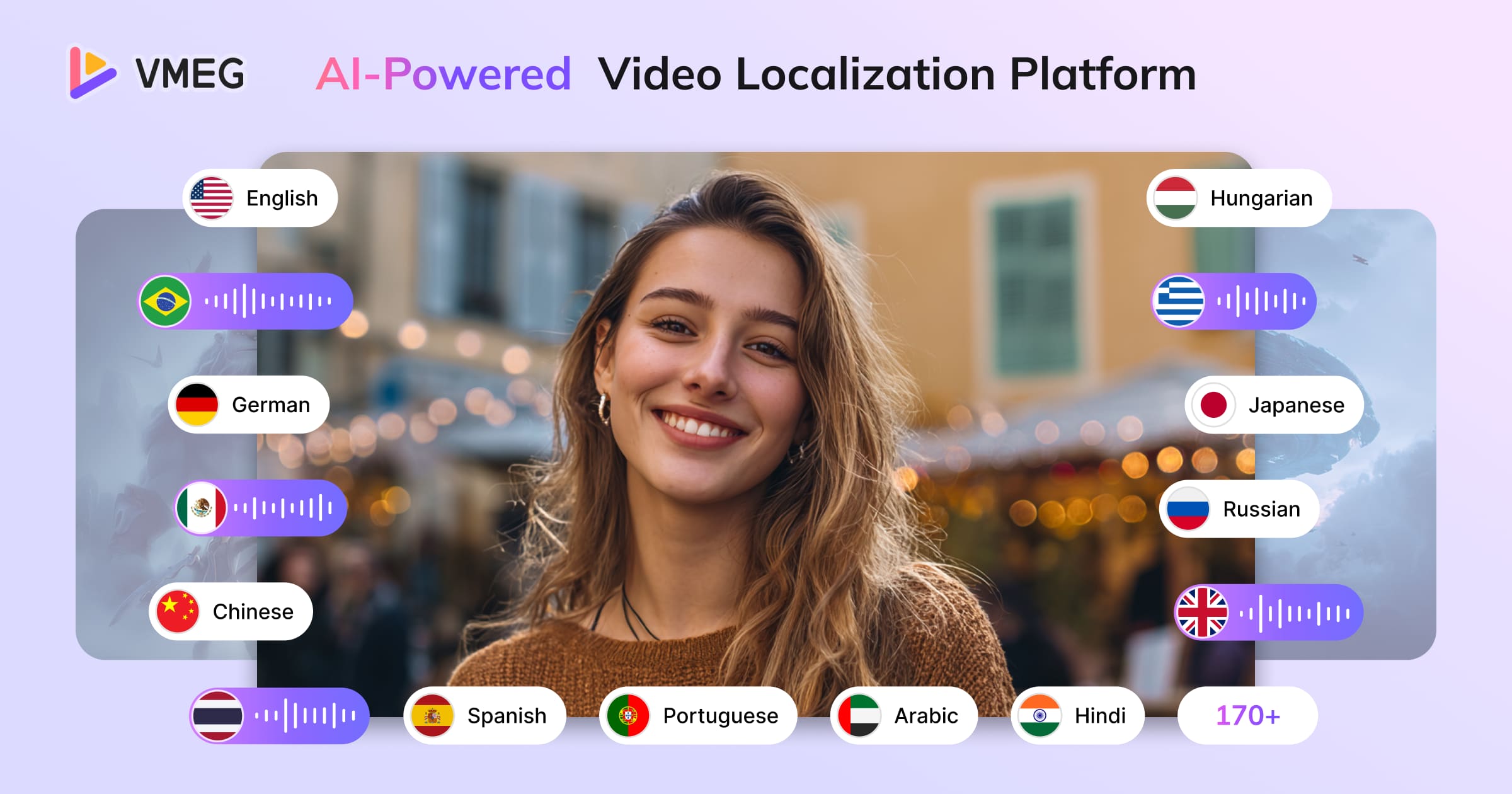What’s the use of having excellent training content if half of your global workforce doesn’t understand it?
In today’s globally dispersed workplace, training films are the preferred format for onboarding, upskilling, compliance, and instruction in soft skills. But a single-language video, no matter how expertly made, creates a knowledge gap. Subtitles sometimes fall short, and rerecording footage in different languages is costly and time-consuming.
That is where AI-powered video translation solutions, such as VMEG AI, are revolutionizing the industry. VMEG AI’s advanced video and audio dubbing, video translating, and lip-sync capabilities enable enterprises to transform any training video into over 170 languages, facilitating global learning.

Alt: Training Video Translation
Why Traditional Translation Methods Fall Short
Translating training content has historically involved several friction points:
- Manual transcription → Human translation → Voice-over studio recording → Post-production editing
This multi-step process is not only costly and slow but difficult to scale when you’re dealing with dozens (or hundreds) of videos across multiple departments or global regions.
Other challenges include:
- Subtitles distract learners, especially in instructional or emotionally nuanced training.
- Voiceover re-recordings often mismatch with the original pacing and speaker tone.
- Lip-sync and speaker identification are rarely handled, making the result robotic or disjointed.
- Multiple speaker videos (e.g., panel discussions or walkthroughs) are especially hard to localize.
In short, traditional methods don’t meet the demands of modern, fast-moving, global organizations.
What Is VMEG AI?
VMEG AI is a next-generation AI-powered platform purpose-built for video localization, dubbing, and translation. Unlike conventional tools that require separate workflows for transcription, translation, voice-over, and editing, VMEG AI combines all these steps into a unified, browser-based environment—allowing creators to localize video content in a matter of minutes.
At its core, VMEG AI leverages state-of-the-art technologies to preserve the original speaker’s tone, identity, and expression—making it ideal for high-quality training videos where clarity, accuracy, and engagement are critical.
Key Features of VMEG AI:
- Support 170+ languages, including regional dialects (e.g., Hindi vs. Tamil, Castilian vs. Latin American Spanish).
- Translate video subtitles into other languages.
- What once took weeks with traditional studios now takes hours.
- Maintains individual voices and speaking order in multi-person content like panel discussions or interviews.
- Voices generated by VMEG are expressive, non-robotic, and emotionally adaptive—crucial for educational clarity and learner retention.
All of this allows VMEG AI to deliver fully dubbed, localized videos—without the traditional overhead of translation studios.
How VMEG AI Solves the Training Localization Problem
Let’s look at how VMEG addresses the most pressing challenges of training video translation:
1. Multi-Language Dubbing in Minutes
Rather than relying on separate subtitle files, VMEG creates a fully dubbed version of your training video. Whether you’re converting English onboarding content to Spanish or Mandarin, the output feels native—retaining the tone, speed, and clarity of the original delivery.
2. Speaker Recognition for Multi-Voice Content
Corporate training videos often involve interviews, demos, or dual-presenter walkthroughs. VMEG AI uses speaker diarization to distinguish and correctly translate each speaker individually—preserving dialogue structure and flow.
3. Lip Sync and Emotion Preservation
Rather than sounding robotic, VMEG adapts voice tone and timing to match the speaker’s facial expressions and mouth movements. This ensures higher learner engagement and more professional results, especially for leadership or client-facing training materials.
4. Scalability and Cost Efficiency
With traditional methods, translating a 20-minute video into 10 languages could take weeks and thousands of dollars. VMEG cuts this to hours, making it ideal for:
- Rapid global onboarding during product launches
- Scalable eLearning content for internal knowledge hubs
Step-by-Step: How to Translate a Training Video with VMEG AI
Here’s how easy it is to translate a training video using VMEG AI
Step 1: Upload Your Training Video
Go to the VMEG AI Video Translator and upload MP4, MOV, MKV, or WEBM format video files directly to the VMEG platform. The platform will fetch the video and analyze its audio.

Alt: Upload a Video to VMEG Video Translator
Step 2: Choose Target Language(s)
Sign in to your account and go to the VMEG dashboard. Here, you can set the target language from 170+ languages, including regional dialects (e.g., Latin American Spanish vs. European Spanish). When everything is configured, click the submit button, and VMEG auto-generates the transcript. This may take 1-2 minutes. Please be patient.

Alt: Set the Target Language
Step 3: Let VMEG Process the Video. VMEG will:
- Detect speakers
- Transcribe original speech
- Translate the script
- Generate dubbed audio
- Align mouth movements
Step 4: Review the Transcript
Once the translation process is complete, you can preview the results, edit the translated text, adjust the voice’s speed, volume, and tone, and switch speakers until you’re satisfied.

Alt: Preview the Translating Results
Step 5: Export the Localized Video
Download a professionally dubbed video in your selected language—ready for deployment on LMS platforms, intranets, or YouTube.
Limitations to Consider
While VMEG AI solves many problems, it’s important to note:
- It requires internet access; no offline processing.
- Real-time translation (e.g., during live webinars) is not yet supported.
- The free tier has limited export credits, which may not suffice for larger enterprises (but it’s great for trial or pilot projects).
Use Cases: Who Can Benefit?
VMEG AI’s training video dubbing capabilities are ideal for:
| Audience | Use Case |
| Multinational Companies | Translate HR onboarding, internal training, and compliance modules into regional languages. |
| eLearning Providers | Localize course videos for global markets without hiring multilingual instructors. |
| HR & L&D Teams | Maintain consistent training content across different countries and cultures. |
| Industrial & Tech Firms | Translate operational and safety training videos into workers’ native languages. |
| Educational Institutions | Provide inclusive, multilingual access to digital training materials. |
Conclusion: Scaling Training Without Language Barriers
As organizations expand across borders, the ability to deliver consistent, high-quality training content in multiple languages has become not just a competitive advantage, but a necessity. Traditional localization methods—often slow, expensive, and resource-intensive—have long been a bottleneck in this process.
VMEG AI offers a practical alternative. By automating the translation, dubbing, and speaker adaptation processes, it enables teams to adapt existing training content quickly and with a high degree of accuracy. Its ability to preserve speaker tone, synchronize audio with visuals, and handle multi-speaker scenarios makes it particularly well-suited for corporate learning environments where clarity and engagement are essential. Try VMEG AI and localize your videos in minutes, not months.





